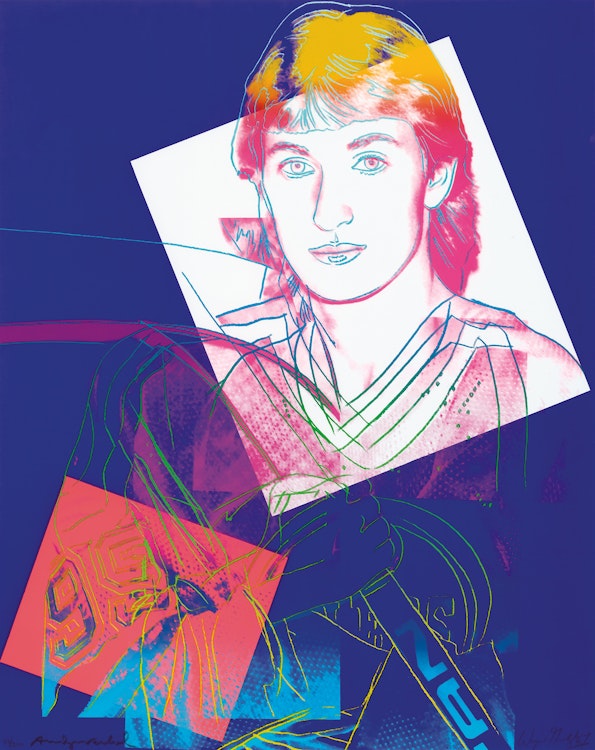Wayne Gretzky #99 (F&S II.306) by Andy Warhol

Andy Warhol
Wayne Gretzky #99 (F&S II.306)
colour screenprint on lenox museum board
signed, numbered 51/300 lower left and signed by Wayne Gretzky and inscribed “99” lower right; printed by Rupert Jasen Smith, New York; published by Frans Wynans, Vancouver
40 x 32 in ( 101.6 x 81.3 cm )
Auction Estimate: $20,000.00 - $30,000.00
Price Realized $33,600.00
Sale date: May 30th 2024
Private Collection
Collection of Art Windsor-Essex
Frayda Feldman and Jörg Schellmann, "Andy Warhol Prints: A Catalogue Raisonné 1962-1987", 4th edition, 2003, catalogue no. II.306
Pat Hackett, "The Andy Warhol Diaries", New York, 2014, page 515
CBC Archives, "When Andy Warhol and Wayne Gretzky Teamed Up for a Portrait", 12 December 2019 [online publication]
–Andy Warhol
Andy Warhol and Wayne Gretzky were brought together by Vancouver gallerist and dealer Frans Wynans hoping to expand his client’s collection of works that focused on The Group of Seven. Gretzky was reportedly a fan of the artist long before their meeting. The idea also appealed to Warhol since, in 1977, he had created his portfolio, "Athletes", featuring ten portraits, including those of Muhammad Ali, O.J. Simpson, Jack Nicklaus and Pelé.
On the day of the sitting at the artist's Manhattan studio, Warhol thought he was being stood up, as Gretzky was over three hours late, due to traffic. Adding to the tense atmosphere, Gretzky arrived without hockey equipment, but the problem was quickly resolved at the sporting goods store just across the street.
A section of Warhol’s diary entry, for Thursday, June 9, 1983, describes the meeting: “Got up early because I had a 10:00 appointment at the office that Fred had made with Wayne Gretzky of the Oilers (cab $6). When I got there they said the Gretzky had just called and said he was coming right down. Meanwhile Fred who had made this early, early meeting wasn’t there yet. By 12:30 I was still the only one there, and I was mad... And finally Gretzky arrived and he was adorable, blond and twenty-two and cute. He doesn’t wear shoulder pads when he plays. I told him he should go into the movies and he said that he was going to be in a "Fall Guy" and a Tom Selleck. He dates a Canadian singer.”
Warhol focuses on “The Great One’s” boyish blond hair and intense stare, highlighted by the neon colours placed on a large white square, which is further offset against the intense blue background. He also uses a large neon pink square to highlight Gretzky’s famous number, ninety-nine, with stylistic coloured outlines drawing attention to the hockey stick he holds, as the last few letters of the hockey logo ‘Titan’ are just visible; a brand Gretzky would be associated with throughout his career.
The original paintings Warhol created from the sitting were originally sold for $35,000, and the screenprints sold for $2,000. Gretzky kept one of the portraits for himself, choosing the one with: “The Oiler colours, if you can see the blue with the orange and white,” he said. “They all look the same, but the colour in that one was the one that I seemed to like the most.”
Cowley Abbott is pleased to work with Art Windsor-Essex (AWE) to support their new endowment fund by offering this work at auction this spring season. This fund was established to support the care and diversification of the collection at the AWE.
Share this item with your friends
Andy Warhol
(1928 - 1987)
Fascinated by consumer culture, fame, and the media, Andy Warhol established himself as one of the most famous and influential artists of the twentieth century. Born in 1928 in Pittsburgh, Pennsylvania, to working-class immigrants from present-day Slovakia, Warhol grew up with an enduring interest in celebrities and mass culture. He studied at the Carnegie Institute of Technology before moving to New York City to become a successful commercial artist and illustrator. During the 1950s, his drawings were published in magazines and displayed in department stores. Yet, Warhol was developing his own style of painting at the same time, inspired by mass culture.
By the early 1960s, Warhol began producing paintings of banal consumer goods, such as soup cans and Coca-Cola bottles, and movie stars, thus establishing his status as the founder of Pop art. He deliberately blurred the lines between high and low art, celebrating popular culture and consumerism unlike ever before. Warhol embraced the photomechanical silkscreen process in 1962 by producing paintings through photography, thus rejecting traditional notions of the handmade and authorship from his works. The fact that his studio was called “The Factory” only reinforced this image. By 1963, he had replaced his silkscreen process for hand painting. Working with assistants, he produced series of flowers, cows, and portraits of celebrities like Marilyn Monroe, Queen Elizabeth II, Liz Taylor and Mick Jagger, among many others. In the early 1970s, he returned to painting after concentrating briefly on making films, producing monumental silkscreen images of Mao Zedong, commissioned portraits and the Hammer and Sickle series. A major retrospective of his work, organized by the Pasadena Art Museum in 1970, travelled across the United States and abroad. Warhol died in 1987 at the age of fifty-eight in New York.

